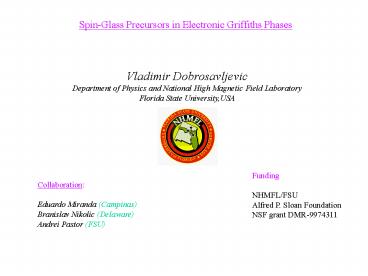SpinGlass Precursors in Electronic Griffiths Phases - PowerPoint PPT Presentation
1 / 15
Title:
SpinGlass Precursors in Electronic Griffiths Phases
Description:
Spin-Glass Precursors in Electronic Griffiths Phases. Collaboration: Eduardo Miranda (Campinas) ... Analytical model of Electronic Griffiths Phase (EGP) ... – PowerPoint PPT presentation
Number of Views:31
Avg rating:3.0/5.0
Title: SpinGlass Precursors in Electronic Griffiths Phases
1
Spin-Glass Precursors in Electronic Griffiths
Phases
Vladimir Dobrosavljevic Department of Physics and
National High Magnetic Field Laboratory Florida
State University,USA
Funding NHMFL/FSU Alfred P. Sloan Foundation NSF
grant DMR-9974311
Collaboration Eduardo Miranda
(Campinas) Branislav Nikolic (Delaware) Andrei
Pastor (FSU)
2
Whats missing from the statDMFT picture of the
EGP?
- Disorder-dependent Griffiths exponent a(W)
c(T) T a-1 - Experiments Kondo alloys, e.g. a 1
(marginal for ALL samples) - (in contrast to doped
semiconductors, e.g. SiP a 0.3) - Physical picture importance of RKKY
interactions for TK lt JRKKY
Spin-Glass ordering of Kondo-unscreened spins?
experiments by D. MacLaughlin, PRL 2001 quantum
spin-glass dynamics at T lt 1K Kondo RKKY,
analytical theory?
3
Contents
- DMFT toy model of the electronic Griffiths
phase (EGP) - an analytical theory of EGP
- Why EGP generally precedes the localization
transition? - - Typical medium theory (TMT)
- Origin of universality of EGP disorder
renormalization - What happens for T gt TK(i) role of RKKY
interactions - Bose-Fermi Kondo model and the destruction of the
Kondo effect - Spin-glass instability of the EGP
- Marginal spin-liquid solution as a spin-glass
precursor
4
DMFT toy model of the EGP (VD E. Miranda,
2002)
DMFT special form of disorder reproduces EGP
Gaussian distribution of random site energies in
the conduction band
Density of states (DOS) seen by local moments
(distribution tail)
Distribution of Kondo temperatures
(Griffiths!!)
5
Electronic Griffiths phase metal-insulator
transition (MIT)
EGP sets in for W gt W (pt2ravJK)1/2
MIT at W Wc EF
Does EGP always come BEFORE the MIT?
DMFT (no localization)
statDMFT (with localization)
Analytical approach TMT
6
Approaching the Anderson transition
- Localization effects in DMFT local DOS
statistics.
Standard DMFT (large coordination)
This gives CPA ( Drude) No localization!!!
Order parameter
7
Typical Medium Theory for Anderson
localization (VD, B. Nikolic, A. Pastor, 2002)
- DMFT-like philosophy
- single site effective medium defined by
self-energy ?(?) - Local Greens function
- Cavity function
- Typical DOS
Results phase diagram
8
Quantitative accuracy transport
- Comparison with exact numerics
- (exact diagonalization, finite size scaling, 3D
cubic lattice) - NOTE no adjustable parameters!
- Conductivity Mooij correlation,
?TMM
Inelastic scattering rate
9
DMFT toy model and universality
- Toy model DMFT specific form for disorder
- statDMFT (with localization, numerics)
universal results - Renormalization of disorder from fluctuating
bath - Physical picture Friedel oscillations from
(many) distant impurities - Universal Gaussian statistics
for renormalized disorder (tails!!)
We can compute Weff(W) for any model (weak
disorder)
10
DMFT toy model of EGP RKKY interactions
- RKKY interactions between (distant) low-TK
(unscreened) spins - oscillatory with distance random
in magnitude and sign - Expect quantum spin-glass (SG) dynamics at low T
- DMFT formulation infinite-range SG interactions
(paramagnetic phase)
- Self-consistency
- Local action Bose-Fermi (BF) Kondo model
- (E-DMFT A. Sengupta, Q. Si,..)
spin operator of the f-electron
11
Bare theory destruction of the Kondo effect
- How RKKY affect the Kondo effect for low TK
spins (stability of the EGP)? - Examine small g-limit
- examine BF model in bath of the bare (toy
model) theory
Exponent e 2 a gt 0 for W gt W1
(pt2ravJK/2)1/2 lt W NOTE e gt 0 leads to
sub-Ohmic (strong) dissipation, phase transition
in BF model
e gt 0
insulator
Fermi liquid
bare EGP
disorder W
MIT
W
W1
12
Decoupling of spins and two-fluid
behavior (paramagnetic solution)
- BF model has a phase transition for a sub-Ohmic
dissipative bath (e gt 0 )
- EGP model distribution of Kondo
- Couplings all the way to zero!
- A finite fraction of spins fall on each
- side of the critical line
- Kondo effect destroyed by dissipation
- on a finite fraction of spins
- Decoupled spins JK flows to zero they
- form a spin fluid (Sachdev-Ye)
- (frustrated insulating magnet)
13
Self-consistent marginal FL solution
average over sites
- Impose self-consistency condition
- Self-consistent solution e1 (same as in
Sachdev-Ye) - Leading contribution from decoupled spins
(spin-fluid) - c(T) ln(To/T)
- Corresponds to renormalized Griffiths exponent
- aR 1 for any W gt W1 (marginal Fermi liquid)
- Renormalized, universal distribution of Kondo
temperatures - (for the spins that remain Kondo-screened)
- PR(TK) (TK)-1/2 (one loop RG result)
- Spin-fluid as quantum critical dynamics as
precursor of the SG phase
14
Spin-glass (SG) instability of the EGP
- SG instability criterion c(T) JRKKY 1
- c(T) ln(To/T) for spin fluid (decoupled spins)
- Finite ( low!!) temperature SG instability as
soon as spins decouple - Generic property of Griffiths phases!
T
Tsl nsl(W) JRKKY
disorder W
15
Summary and Open Questions
- Analytical model of Electronic Griffiths Phase
(EGP) - EGPRKKY interactions non-Ohmic dissipation
- Destruction of Kondo effect on low-TK spins,
two-fluid behavior - Low temperature spin-glass instability as
generic property of EGP - Marginal Fermi liquid behavior as quantum
critical dynamics of SG - Quantitative extend (size) of SG and spin-fluid
phases??? - Nature of the T0 SG-FL quantum critical point
(non-Hertz in any D?) - Limitation of infinite range model for decoupled
spins (local singlets?)































